
Christ Washes the Disciples' Feet is a 1622 oil on canvas painting by Battistello Caracciolo for the church of the Certosa di San Martino in Naples, where it still hangs. [1] It is held to be one of the artist's masterpieces. [1]

Christ Washes the Disciples' Feet is a 1622 oil on canvas painting by Battistello Caracciolo for the church of the Certosa di San Martino in Naples, where it still hangs. [1] It is held to be one of the artist's masterpieces. [1]
Commissioned in April 1622 according to the allocation contract (which survives in Naples' state archives), it was hung on the left wall of the choir of the church that September [2] and later joined on the same wall by Ribera's The Last Supper . [3] It marked Caracciolo's triumphant return to Naples after a long absence, probably involving a visit to Rome, work in Genoa and a stay in Florence.

Belisario Corenzio was a Greek-Italian painter, active in Venice and Naples. He is one of few Greek painters that did not belong to the Cretan Renaissance like his contemporaries of the time. He escaped the maniera greca completely. He adopted the Venetian style. Other similar Greek painters were Marco Basaiti, Ioannis Permeniates, Antonio Vassilacchi and El Greco. He was sometimes referred to as Il Greco. His teacher was prominent Venetian painter Tintoretto. In 1590, at age 32 Corenzio settled in Naples. Corenzio was influenced by Cavalier d'Arpino. He continued to flourish in the region. His apprentices included: Luigi Rodriguez, Andrea di Leone, Onofrio De Lione and Massimo Stanzione. Corenzio painted many frescos that survived today. Some of his works are in the Church of San Severino and Certosa di San Martino. His style resembles Caravaggio. An Italian legend in Naples exists involving Corenzio, Spanish painter Jusepe de Ribera, and Battistello Caracciolo. They were referred to as the Cabal of Naples. The three painters were rumored to have poisoned their competition for painting contracts. The rumors lack documented evidence. The three painters were very popular in Naples. Corenzio frescoed the Crypt that holds the remains of Matthew the Apostle at Salerno Cathedral and it depicts scenes from the Gospel of Matthew. Corenzio was one of the most celebrated fresco painters in Naples during his time. His drawings can be found all over the world namely at the Metropolitan Museum, Museo di Capodimonte and Louvre. More recently, his life and work was studied by the Greek art historian Panayotis K. Ioannou in a comprehensive monograph.

The Denial of Saint Peter(La Negazione di Pietro) is a painting finished around 1610 by the Italian painter Caravaggio. It depicts Peter denying Jesus after Jesus was arrested. The painting is housed in the Metropolitan Museum of Art in New York City.

Cosimo Fanzago was an Italian architect and sculptor, generally considered the greatest such artist of the Baroque period in Naples, Italy.

Giovanni Battista Caracciolo (1578–1635) was an Italian artist and important Neapolitan follower of Caravaggio. He was a member of the murderous Cabal of Naples, with Belisario Corenzio and Giambattista Caracciolo, who were rumoured to have poisoned and disappeared their competition for painting contracts.
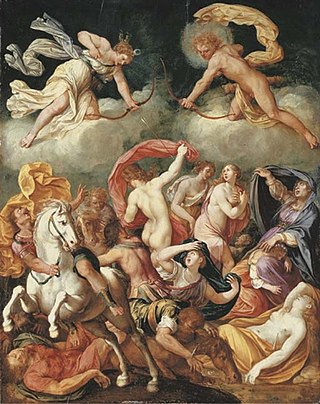
Bernardino Cesari was an Italian painter of the late-Mannerist and early Baroque period, active mainly in Rome and Naples, where he assisted his brother Giuseppe Cesari.

Paolo Domenico Finoglia, or Finoglio, was an Italian painter of the early-Baroque period, active mainly in South Italy, including Naples and towns in Apulia.

San Paolo Maggiore is a basilica church in Naples, southern Italy, and the burial place of Saint Cajetan, founder of the Theatines. It is located on Piazza Gaetano, about 1-2 blocks north of Via dei Tribunali.
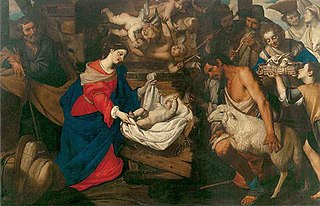
Pacecco De Rosa was an Italian painter, active in Naples.

San Francesco delle Monache is a Baroque-style church located in via Santa Chiara, in Naples, Italy.

Santa Maria degli Angeli a Pizzofalcone is a Baroque-style church in Naples, Italy.

San Diego all'Ospedaletto, also known as San Giuseppe Maggiore, is a Baroque-style church located on via Medina in the rione Carità in Naples, Italy. It is located across the street from the tall modern NH Ambassador Hotel and diagonal from the Palazzo Giordano and Questura.

The Royal Chapel of the Treasure of St. Januarius, or the Reale cappella del Tesoro di San Gennaro, is a chapel located in the Cathedral of Naples, Italy, and dedicated to St. Januarius, patron saint of the city. This is the most lavishly decorated chapel in the cathedral, and contains contributions by the premier Baroque artists in Naples.

The church of Santi Severino e Sossio and the annexed monastery are located on via Bartolommeo Capasso in Naples, Italy.

Michelangelo Naccherino was an Italian sculptor and architect, active mainly in the Kingdom of Naples, Italy.
Bartolomeo Passante or Bassante was an Italian painter of the Baroque era active in Naples.
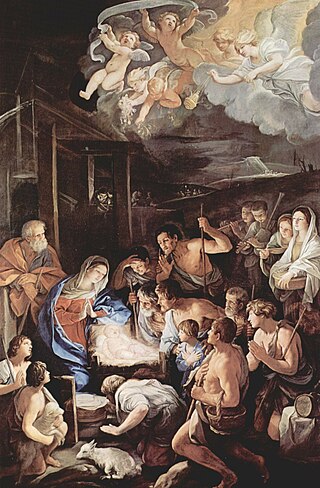
Adoration of the Shepherds is a c. 1642 oil on canvas painting by Guido Reni, commissioned by Giovan Battista Pisante, prior of the Certosa di San Martino in Naples, and still hanging on the main wall of the choir of that institution's church.
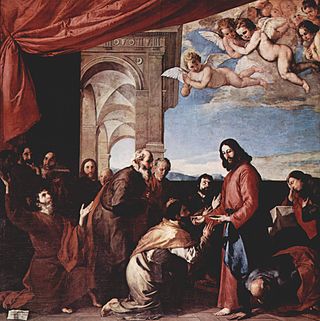
The Last Supper or The Communion of the Apostles is a 1651 oil on canvas painting by Jusepe de Ribera, still in the choir of the Certosa di San Martino in Naples, for which it was commissioned.
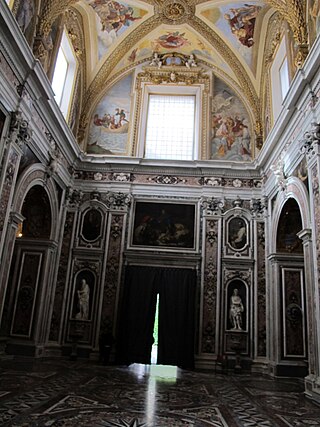
Prophets and Patriarchs is a series of fourteen oil on canvas paintings produced between 1638 and 1643 by Jusepe de Ribera along the nave walls of the church of the Certosa di San Martino in Naples, where they still hang. Moses and Elijah hang behind the west facade, whilst the rest hang under the arches of the side chapels.

The Pietà is a 1638 oil on canvas painting by Massimo Stanzione, commissioned in 1638 for the Certosa di San Martino, where it still hangs. He also treated the subject in a 1621-1625 work now in the Gallerie nazionali d'arte antica in palazzo Barberini, Rome.

Baptism of Christ is a 1610-1615 oil on canvas painting by Battistello Caracciolo, now in the Girolamini, Naples.